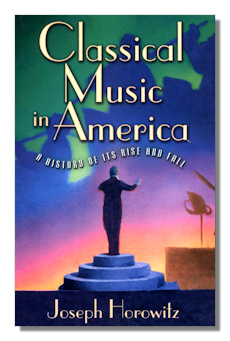
The Internet's Premier Classical Music Source
Related Links
-
Introduction
Acoustics
Ballet
Biographies
Chamber Music
Composers & Composition
Conducting
Criticism & Commentary
Discographies & CD Guides
Fiction
History
Humor
Illustrations & Photos
Instrumental
Lieder
Music Appreciation
Music Education
Music Industry
Music and the Mind
Opera
Orchestration
Reference Works
Scores
Thematic Indices
Theory & Analysis
Vocal Technique
Search Amazon
Recommended Links
Site News
 Book Review
Book Review
Classical Music in America

A History of Its Rise and Fall
Joseph Horowitz
Norton, 2005. 606 pages.
ISBN-10: 0393057178
ISBN-13: 978-0393057171
Towards the very end of this lengthy book, its author tells a story about Esa-Pekka Salonen, the point of which strikes close to the heart of one of Horowitz' main concerns: the high value accorded the performer at the expense of the composer. In Paris for a performance by the French National Orchestra of one of his compositions, Salonen found himself booked into "a little bed and breakfast kind of place." Sharing with his wife his distaste for the accommodations, Salonen said, "'Look at this dump. How could any human being exist in this kind of place? It's just awful.' And she looked at me and said, 'Look, you are being treated as a composer, don't forget.' That was a very good lesson, because I was the same guy who, when conducting, was staying at five-star hotels in Paris. It's crazy, ridiculous, but that's how it is" (p. 532, quoting an interview in Symphony, 54:2.)
Paradoxically, then, what this book is mainly about is the history of symphony orchestras, opera companies, conductors and soloists from the mid-nineteenth century to the present. Horowitz does include an historical survey of American composers, but his main interest is what music conductors have chosen to program.
Horowitz writes about what he wants to write about. He does not give proportionate space to different places, institutions or individuals. He does not try for temporal balance either. Half his book tells the early history of music in Boston and New York during the nineteenth century. His interpretive narrative is "laden with analysis and criticism," and Horowitz admits at the outset that he does not even try to be "objective."
As in his 1995 collection of essays, The Post-Classical Predicament, Horowitz begins with Dvorak's New World Symphony and ends up with an account of artists' managers who have driven up the price of conductors and soloists. What interests him about the Dvorak is that composer's decision to include African American and Native American elements, and the possibilities of an American sound, and throughout Horowitz appears to lament the fact that more American-and contemporary - music is not performed in America. The conductors Horowitz most admires are Koussevitsky and Stokowski, as well as Mitropoulos, who did make strong efforts on behalf of living composers. The conductors least celebrated in this account are Toscanini (about whom Horowitz published another long book), Reiner and Szell.
The reason for Horowitz' preference is that the careers of the latter-mentioned group of conductors-especially Toscanini - brought about the heavy emphasis on performance of standard repertoire at the expense of lesser-known works, especially works by living composers. The idea grew that "only great works are worthy of great conductors." Audiences and critics came to focus on the performance even more than on the work itself. This is the main theme of this book and it is what most interests me about the book.
A subsidiary theme of the book is the tension between elitism and populism on the part of critics, box-holders, and some composers. Horowitz takes issue with Lawrence Levine, the author of Highbrow/Lowbrow, The Emergence of Cultural Hierarchy in America, by noting the insistence on inexpensive tickets right from the beginning of the Boston Symphony Orchestra.
The composers Horowitz appears most to like include Chadwick and Gershwin. He discusses Copland, Bernstein and Ives also but thinks little of the work of the many American neoclassical symphonists in general. He accepts the disappointment of Copland in the ending of Roy Harris' Third Symphony. He is dismissive of the compositions of Barber and utterly dismissive of Hanson, though in passing he notes that Barber's Violin Concerto is much performed and Hanson recorded many American works. I cannot let go of the question: Just what does he want?
I have problems with Horowitz' subtitle. Mainly I am not entirely clear on what he means by it. The conductors he most and least likes are long gone; the culture of performance is simply a fact, as Salonen's quote above noted, and even in the earliest period there was what Horowitz calls the "sacralization" of Beethoven and other composers. To be sure, classical broadcasts have mostly disappeared from network radio and television; the large recording companies have mostly given up recording American orchestras; Time and Newsweek no longer have coverage of classical music, and far fewer people than formerly in the American population claim an interest in classical music. But surely classical music has always been a minority taste; there are vastly more orchestras than there were early in the twentieth century, not to mention the nineteenth; and Horowitz notes that the average age of concert-goers has not gone up (which surprised me). We are undoubtedly in a post-modern period, but Horowitz' notion that we are in a post-classical era seems premature to me. Some of his perceptions come from his administrative experience with the Brooklyn Philharmonic, attendance of which had plummeted before he worked there. Other sources of his view perhaps come simply from his personal tastes and preferences. Frankly he even seems to reflect a personal malaise. Nonetheless, this book is well worth reading.
Copyright © 2005 by R. James Tobin.


















